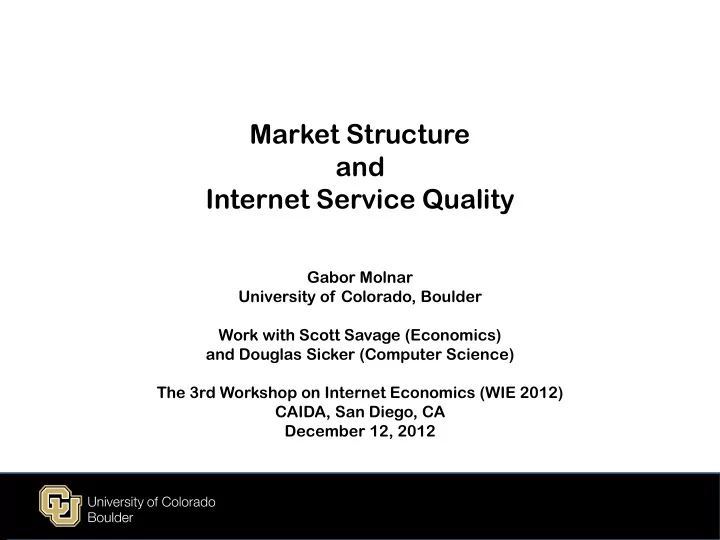

Market Structure and Internet Service Quality Gabor Molnar University of Colorado, Boulder Work with Scott Savage (Economics) and Douglas Sicker (Computer Science) The 3rd Workshop on Internet Economics (WIE 2012) CAIDA, San Diego, CA December 12, 2012
Topics cs & aspects ts • How Internet Service Providers compete? Wireline & wireless • Does wireless compete with wireline or broadband: are they the same? are they independent products? • What is the relationship between the What are the important number of competitors & Internet quality? parameters and how • How does this relationship vary with the might the definition change over time? type of competitor (wireline vs. wireless)? • Quality as a multidimensional construct How to define quality?
Master Database FCC sponsored field test of wireline access network performance (SamKnows) Actual broadband data rates (March & June 2011) No interference from home network All regions & major ISPs Popular Internet plans only No demographic information
Two-step model to study empirical data Step 1 : Investigate market structure by looking at economic factors that determine market entry Economic factors (e.g.): population, Dependent variables: # of wireline & income, age, education, area, pop. wireless providers in CBGs growth, firm count, regulations Step 2 : Estimate if the number of wireline & wireless Internet service providers affect quality Dependent variables (quality): Independent variables: # of wireless and wireless ISP’s, economic factors, sustained & burst data rate (u/s, d/s), jitter, latency, packet loss unobservables
Results (work-in-progress) Market structure Entry patterns are similar for wireline & wireless firms. Entry more likely in markets with more firms, population (level & growth), younger persons & more densely populated area. Wireline ISPs prefer markets with Wireless ISPs prefer markets with more educated persons & with less water area & with less less wireless competitors . wireline competitors .
Results; cont’d (work -in-progress) Broadband quality Positive correlation between Marginal effect of competition competition (i.e., number of on quality varies with the wireline & wireless ISPs) & number of firms in the market. quality of wireline access.
Service Quality: back to the roots * • Gap Model 2 (multiple aspects, linear approach) • Perceived Quality Model 3 (multidimensional approach) • Technical quality (what is being delivered) Quality is a measure of • Functional quality (how it meets expectations) how well the service • Image (affects both experience & expectations) level matches customer expectations 1 * Oliver (1980), Lehtinen & Lehtinen (1982), Lewis & Booms (1983) 1 , Parasureman et al. 2 (1982), and Grönroos 3 (1983)
Future Works Extend the one-dimensional, technical methods of measuring quality into a multi- dimensional approach Use a Quality Tensor to allow for a more complex assessment of service quality and customer experience Add pricing information Cross-reference existing performance databases (M-Lab, Ookla, Netflix?)
Summary Market entry patterns are similar for wireline & wireless ISPs Wireline and wireless are imperfect substitutes Competition does have an effect on wireline Internet service quality Empirical Study; preliminary results It is timely to extend existing methods for broadband service quality assessments
THANK YOU! Questions?
Recommend
More recommend